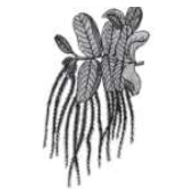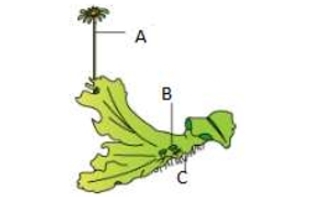The given diagram shows:

1. An alga that lacks flagellated cells
2. A liverwort
3. A heterosporous pteridophyte
4. A gymnosperm with non motile sperms

Identify the statement that most accurately describes the plant shown in the given figure:

1. This the male prothallus of Marchanita; A is antheridiophore and B is Gemma cup
2. This the female prothallus of Marchanita; A is archegoniophore and B is Gemma cup
3. This the male prothallus of Sphagnum; A is antheridiophore and B is Gemma cup
4. This the female prothallus of Sphagnum; A is archegoniophore and B is Gemma cup
The diploid sporphyte is represented by a dominant, independent, photoshynthetic, vascular plant body. It alternates with multicellular, saprophytic/autotrophic, independent but short-lived haploid gametophyte. This type of pattern is exhibited by
1. Bryophytes (Sphagnum, Polytrichum).
2.Pteridophytes (Selaginella, Lycopodium).
3. Most of the algal genera (Fucus, Chara, Polysiphonia).
4. Seed plants (gymnosperms and antiosperms).
The type of life-cycle in which there is no free-living sporophytes and the dominant, photosynthetic phase in such plants is the free-living gametophyte. We are talking about
1.Haplontic life cycle shown in Volvox and some species of Chlamydomonas.
2.Diplontic life cycle as shown in seed-bearing plants.
3.Haplo-diplontic life cycle as shown in bryophytes and pteridophytes.
4.Haplo-diplontic life cycle as shown in Kelps.
Read the following statements :
A. The male or female cones or strobili may be borne on same tree in Pinus.
B. In Cycas male cones and megasporophylls are borne on different trees.
C. Stem of Cycas is branched and of Pinus and Cedrus is unbranched.
D. In gymnosperms generally tap roots are found.
Select the correct statements.
1. A, B
2. A, B, D
3. A, B, C
4. C, D
Prothallus is
1. A structure in pteridophytes formed befor4e the thallus develops.
2. A sporophytic inconspicuous free living structure formed in pteridophytes.
3. A gametophytic inconspicuous free living structure formed in pteridophytes.
4. A gametophytic conspicuous structure formed after fertilization in pteridophytes.
Leafy stage develops from the secondary protonema as a
1. Apical bud
2. Axillary bud
3.Lateral bud
4. Meristem
In Phaeophyceae, the spores (zoospores) are
1. Pyriform and bear 2 flagella (one longitudinal and other transverse).
2. Pear-shaped and bear 2 flagella that are laterally attached.
3. Pyriform and bear 2-8, equal and apial flagella.
4. Pear-shaped and bear 2-8, equal and apical flagella.
In chlorophyceae and phaeophyceae, the type of sexual reproduction is
1.Isogamous 2.Anisogamous
3.Oogamous 4. All of the above
Read the following statement and find out the incorrect statement.
1. Algae usually reproduce vegetatively by fragmentation, asexually by formation of different types of spores and sexually by formation of gametes.
2. Algae are classified into three classes, pteridophytes into four classes and antiosperms into two classes.
3. Algae are chlorophyll bearing simple, thalloid, autotrophic and largely aquatic organisms.
4. The plant body of algae is more differentiated than that of bryophytes.




